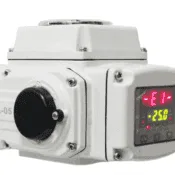



COVNA L Type 3 Way 12v 24v Electric Actuated Ball Valve
The COVNA Miniature 3-Way Motorized Ball Valve is built with brass and stainless steel and is available in modern gray and black finishes. It operates on AC110V–230V or DC9V–24V and comes in sizes from 1/2” to 2”. Designed to prevent leakage while ensuring excellent sealing, it also features a user-friendly ON/OFF timer control and supports OEM branding. This versatile valve is proven in various industrial settings, including air conditioning, firefighting, water treatment, pipeline purging, analytical instruments, and flue gas sampling.
- Model: HK62-S-T
- Size Range: 1/2″ to 1″
- Pressure Range: 0~1.0MPa
- Material: Stainless Steel or brass
COVNA 3-WayElectric Water Ball Valve
This product features low operating current with battery power capability. It employs an all-copper gear design for high-precision torque output, especially suited for multi-channel scaling systems. Serving as a diverter valve, it efficiently controls fluid flow in applications like HVAC, solar equipment, and water filters. The valve supports various control modes, accepting remote position signals while providing local feedback for intelligent computerized testing, and it delivers excellent sealing with an IP67 protection rating.
Technical Parameters of Valve Body
Model | HK63-S-T | Voltage | AC110V~230V, DC9~24V |
MOQ | 1 Set | Working current | ≤500mA |
Open/Close time | ≤5s | No. of Ways | 3 Way |
Torque output | 2.0N.M | End Connection | BSP Thread |
Life time | 70,000 times | Medium | Water, Air |

Body Material | Brass, ss304, ss316(optional) | Temp. of Media | 2°C to 90°C |
Valve Ball | PVC, UPVC, Brass, Stainless Steel(Optional) | Certification | ISO 9001, CE, TUV, SGS |
Sealing Material | EPDM | Indicator | Yes |
Keeping Valve Open Time | 0H:0M:OS-99H:59M:59S | Manual override | NO |
Actuator material | Engineering Plastics | Ambient temperature | -15°C to 50°C |




